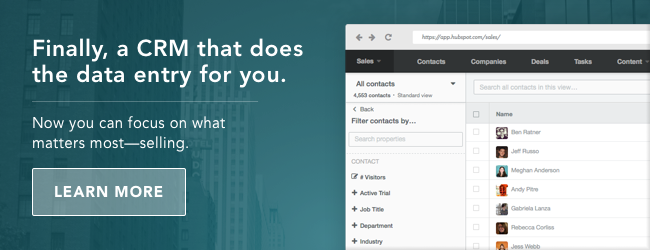
This post originally appeared on HubSpot’s Sales Blog. To read more content like this, subscribe to Sales.
It’s hard to underemphasize the power of referrals in business today. According to a PeopleMetrics study, 78% of B2B prospects kick off their buying processes by asking for network referrals. With this in mind, businesses should strive to get referred to new potential customers before reaching out.
But what if you don’t share any connections or acquaintances with a them? Recommendations are the next best thing. A glowing recommendation from an existing customer provides social proof that can put new prospects’ minds at ease.
However, not just any recommendation will bolster your reputation. It has to be written by the right person, about the right topic, at the right time.
Use these tips to source personalized, persuasive LinkedIn recommendations that will make your profile stand out against a sea of competitors.
5 Tips for Earning More High-Quality LinkedIn Recommendations
1) Think about what you’d like to communicate.
Not every recommendation serves the same purpose. Are you looking for a new job? Trying to attract new customers? Attempting to make a drastic career shift?
Before you ask for a recommendation, think about what you’re trying to accomplish, as this will impact who you’ll ask and how you direct this person. For example, if you’re looking for a new job, a recommendation from a manager or colleague about exemplary work performance will help you stand out to recruiters and hiring managers. But if you’d like to source new customers, a recommendation from an existing customer detailing the results you helped them achieve will mean the most to prospects.
2) Identify the person you’d like to recommend you.
Next, zero in on the person you want to write a recommendation. Keep in mind that the best person to write a recommendation isn’t always the one you’re closest with, or the one with the most impressive title.
Here are some guidelines that can help you find the perfect person to recommend you. Choose someone that:
- you have worked with for six months or more
- you worked with closely for a period of time
- has experience with other professionals like you
- has benefited in a material way from your work
- is in a similar industry or holds a similar job to the target audience you’d like to attract (customers, recruiters, executives, etc.)
- is a strong writer
- regards you in a positive light (obvious, but critical.)
3) Identify two to three topics you’d like the person to focus on.
Generic recommendations like the below aren’t all that effective:
Sure, these statements are nice. But what do they really say about you in particular? These accolades could be applied to almost anybody.
Odds are, you’re hoping a recommendation will get you chosen for something — a job, a deal, an organization. With this in mind, recommendations need to be specific enough to convince the decision maker to select you specifically, and not just someone like you.
To ensure you get a customized recommendation, prompt the person you ask with a couple topics or questions. Just make sure to do it gently and courteously. After all, this person is doing you a favor — you don’t want to seem demanding.
Here’s an example of how you might phrase your prompts:
“I’m really proud of the work we did on the Corp Inc. project. Could you write a bit about that initiative and what our collaboration and results were like?”
In addition, consider adding a length guideline. This serves two purposes. First, it gives people an idea of how long this task will take. Second, it relieves the stress of wondering whether they’re writing too much or too little.
LinkedIn cuts recommendations off after approximately 65 words and adds a “see more” tag. With this in mind, a solid length parameter is three to five sentences.
4) Offer value.
You should never ask for something without offering value first. Before sending your recommendation request, find something to send to your contact, such as an interesting blog post, webinar invitation, research report, or even a referral.
Instead of thinking about what you find most interesting, think about what would be most helpful to your contact. Spend some time searching for something truly valuable if you expect to receive a well thought out recommendation in return.
5) Send the request.
All that remains now is sending the request. You can either do this through email, or directly through LinkedIn.
- Hover over your picture in the upper right corner
- Click “Privacy and Settings” from the drop-down menu
- Click “manage your recommendations”
- Choose a position, and click “ask for a recommendation”
Although LinkedIn allows you to request recommendations from up to three people at once, your request should be customized enough to only be appropriate for one specific person.
One benefit of sending your request through LinkedIn is that you can nudge the person if they are unresponsive. Simply click the “remind” button under the person’s profile on your Recommendations screen.
Email Template to Request a LinkedIn Recommendation
Hi [first name],
I hope all is well with you. I recently came across this ebook on [topic they care about] that I thought would interest you:
[link to content asset]
You’ll find section X particularly valuable.
I really enjoyed working with you on/at [project/company], and I was wondering if you would write a brief LinkedIn recommendation of my work. I’d love it if you could touch on Y initiative and our collaboration on Z. Just three to five sentences is all I’m after.
I know a recommendation from you will significantly elevate my profile. I greatly appreciate your time, and hope to hear from you soon.
Thank you,
[your name]
How do you ask for LinkedIn recommendations? Share your approach in the comments.
![]()






